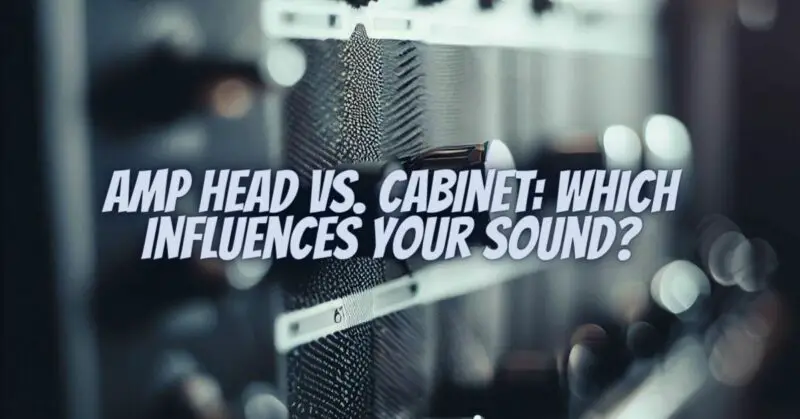When it comes to crafting the perfect guitar tone, musicians often find themselves at a crossroads, faced with a pivotal decision: choosing between an amplifier head and a speaker cabinet. These two components of a guitar rig play distinct but equally vital roles in shaping the overall sound. In this article, we’ll explore the differences between amp heads and cabinets and discuss how each influences your sound.
Amp Head: The Heart of Your Tone
The amplifier head, often simply referred to as the “amp head,” is the central component responsible for amplifying the electrical signal produced by your guitar. It’s where the magic begins. Here are some key aspects of amp heads and their influence on your sound:
- Tonal Character: Amp heads are the primary source of your amp’s tonal character. Different amp heads, whether they are tube, solid-state, or modeling, offer distinct sonic qualities. Tube amp heads, for example, are known for their warm, organic, and responsive tones, while solid-state amps tend to be cleaner and more consistent.
- Gain Stages: Amp heads typically have various gain stages, allowing you to control the amount of distortion or overdrive in your sound. This control over gain is essential for achieving the desired level of crunch or saturation in your guitar tone.
- Equalization: Most amp heads come equipped with a built-in equalization section, consisting of bass, midrange, and treble controls. These allow you to shape the tonal balance to suit your preferences and the genre you’re playing.
- Effects and Features: Many modern amp heads include built-in effects such as reverb, delay, and modulation. These features can significantly influence your sound and save you from needing external effects pedals.
- Wattage: The wattage of an amp head affects its volume and headroom. Higher-wattage amps can achieve greater volume levels before breaking up, while lower-wattage amps tend to saturate at lower volumes, providing a more compressed and distorted sound.
- Versatility: Some amp heads are designed for specific genres or playing styles, while others offer greater versatility, allowing you to explore a wide range of tones. The choice of amp head can, therefore, impact your sonic flexibility.
Speaker Cabinet: The Voice of Your Amp
While the amp head sets the foundation for your tone, the speaker cabinet is where that tone is projected into the world. Here’s how speaker cabinets influence your sound:
- Speaker Choice: The type and number of speakers in your cabinet have a profound impact on your sound. Different speakers can emphasize different frequency ranges and contribute to the overall character of your tone. For instance, Celestion Vintage 30s are known for their midrange punch, while Jensen speakers often offer a cleaner, vintage-inspired sound.
- Speaker Size: The size of the speakers in your cabinet also matters. Smaller speakers tend to produce a tighter, focused sound, while larger speakers can create a fuller, more open sound. For instance, 10-inch speakers are often associated with punchy, articulate tones, while 12-inch speakers are favored for their balanced response.
- Cabinet Construction: The design and construction of the cabinet can affect resonance and projection. Closed-back cabinets tend to provide a more focused sound with less low-end dispersion, while open-back cabinets offer a more spacious and airy tone.
- Matching: Pairing the right speaker cabinet with your amp head is crucial. Different combinations can either complement or clash with each other, leading to varying tonal results. Experimentation is key to finding the perfect match.
- Volume and Projection: The speaker cabinet plays a pivotal role in how your sound is distributed in a live or studio setting. The cabinet’s size and speaker configuration can impact your projection, making it important to consider the venue and context in which you’ll be playing.
The Symbiotic Relationship
In the quest for the ultimate guitar tone, it’s important to recognize that the amp head and speaker cabinet are not standalone entities; they work together in a symbiotic relationship. The amp head provides the initial tonal characteristics and gain structure, while the cabinet imparts its own unique voice and projection.
Experimentation is the key to finding your ideal sound. Musicians often swap out different amp heads and cabinets to discover new tones and textures. Here are a few tips for navigating this journey:
- Try Before You Buy: Whenever possible, test different amp head and cabinet combinations to find the synergy that suits your style and preferences.
- Consider Your Genre: Different genres often demand specific tonal qualities. Research the gear choices of musicians in your genre for inspiration.
- Don’t Overlook Speaker Cabinets: While amp heads often receive more attention, the choice of speaker cabinet is equally crucial in shaping your sound.
- Understand the Venue: Consider the size and acoustics of the venues where you’ll be playing. Your gear should be suitable for the environment.
- Embrace Versatility: If you’re a versatile player, opt for gear that allows you to explore a wide range of tones.
In conclusion, the choice between an amp head and a speaker cabinet is not a matter of one being superior to the other. Instead, it’s about understanding how they each contribute to your sound and making informed choices based on your musical goals and preferences. Whether you’re chasing vintage blues tones, modern metal mayhem, or anything in between, the right combination of amp head and cabinet can be your ticket to tonal nirvana.


